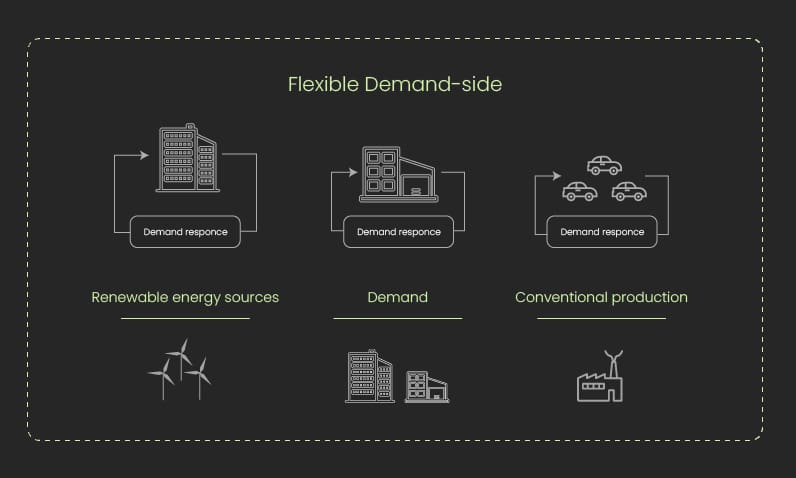Energy keeps everything running, from our homes and businesses to more and more of our transportation. But as our energy use changes and grows, managing our power grids has become a real challenge. This is because the way we produce and use energy is constantly shifting. This makes it tricky for utility companies and grid operators to keep everything balanced.
The problems with traditional power grids
We’re facing a major energy challenge. Our power supply doesn’t always match our needs. Traditional power grids were designed to produce just enough electricity to meet peak demand. This is both inefficient and increasingly problematic.
Our energy habits are evolving. Imagine a hot summer day when everyone cranks up their AC. This sudden surge can push power plants to their limits, risking outages. It’s also expensive and environmentally harmful.
This change puts a lot of pressure on our old energy systems, showing that we need a more flexible and quick-to-respond approach.

The impact of renewable energy on the grid
Switching to green energy is awesome for the planet, but it’s causing big headaches for grid operators. Wind and solar power – the fastest-growing renewables – are unpredictable. Their output depends on weather, sunlight, and seasons, making them harder to manage than traditional power plants.
Imagine this, on a perfect sunny and windy day, we might generate more green energy than we can use, so some of it gets wasted. But on a still, cloudy day, those same sources might barely produce anything, forcing us to start up backup plants quickly.
This unpredictability changes everything. It’s not just about making enough power anymore – it’s also about getting the timing and location right. The big question is “How do we fit these eco-friendly but unpredictable energy sources into our grid without losing reliability?”
What is demand response?
Demand response is a system where consumers change their electricity use based on signals, like price changes or incentives. This helps balance energy supply and demand, reducing costs and maintaining grid stability.
The demand response market has been expanding with notable growth in various regions. For instance, the United States registered 29 GW of peak demand savings potential in 2021 across all demand response programs, involving over 10 million customers. In Japan, demand response contributed 90 million kW during winter 2022, a substantial increase from previous years
Demand-response, the right solution!
On the one hand, energy use is rising, and on the other, we generate more power from eco-friendly but unpredictable sources. But we don’t need to worry – we have demand response systems to tackle this issue.
A Demand Response (DR) system is a smart way to keep the balance between energy supply and demand. Basically, a DR system lets energy users change their electricity usage based on grid conditions. This usually comes with some financial perks.
Instead of just focusing on adjusting the supply to meet demand, DR systems add flexibility on the demand side. This creates a more interactive relationship between energy providers and consumers. This allows for real-time changes to keep the grid stable and efficient. And, is one of the many benefits of using custom energy management software.

Examples of DR Events
The core part of a demand-response system is the DR Event. Such events can be sent from one place and are handled in other places. DR events can take many forms, depending on what the grid needs and what consumers can do. Here are some real-world examples:
- During a heatwave, a DR system might ask participating households to alter their thermostat settings. This small change, when done by thousands of homes, can significantly reduce the strain on the grid during peak hours.
- In the industrial sector, a manufacturing plant might get a DR signal about high energy prices due to peak demand. The plant could then reduce power to non-essential processes or shift energy-intensive operations to off-peak hours.
- For EV owners, a DR system could offer lower charging rates when there’s a lot of renewable energy available. This helps balance the grid and allows EV owners to use cleaner, potentially cheaper electricity. This will especially impact how a payment system for EV charging terminals might work.
Did you know?
The global smart grid market was valued at approximately $29.45 billion in 2020 and is expected to grow to $140.53 billion by 2028. This growth is driven by significant investments in grid modernization, particularly in regions like North America and Asia Pacific.
Reports & monitoring in DR systems
DR systems rely on accurate, timely data and smart analytics to be effective. Modern DR platforms offer valuable info to energy providers and consumers:
- Real-time energy usage data lets consumers see their patterns and DR participation impact. Utilities use this data to predict demand trends and identify DR opportunities.
- Grid status reports give operators an overview of current demand, available supply (including renewables), and potential stress points. This helps them decide when to start DR events.
- Predictive analytics use past data, weather forecasts, and more to anticipate future energy needs. The impact of this allows for proactive grid management.
- Post-event analysis measures the effectiveness of DR events. This can provide insights for improving future responses and refining incentives.
OpenADR
Good communication between stakeholders is key when it comes to DR. This is where OpenADR (Open Automated Demand Response) comes in. OpenADR is a standardized language that lets energy providers, consumers, and devices communicate.
Created by the OpenADR Alliance, this open-source standard is essential for modern DR systems. It provides a common framework for sending and receiving DR signals. This means different systems and devices can understand and respond to these signals, no matter their manufacturer or specific setup.
Renewable energy targets
The EU has set ambitious goals to increase its renewable energy capacity. By 2030, the EU aims to derive at least 32% of its energy from renewable sources. This includes substantial investments in offshore wind energy, with a goal of reaching 120 GW of capacity by 2030, involving countries like Denmark, Germany, and others around the North Sea.
What is OpenADR 2?
OpenADR 2.0, the current widely adopted version, and is a big step forward in DR technology. It features a two-way communication model. It allows top-down control from utilities to consumers, more feedback, and complex interactions.
This version has played a crucial role in the growth of DR programs worldwide. It provides a standardized platform that reduces implementation costs and improves interoperability.
What about OpenADR 3?
While OpenADR 2.0 has been successful, the evolving energy landscape calls for even more advanced capabilities. Enter OpenADR 3, the next generation of the standard, currently under development. OpenADR 3 aims to address emerging challenges and opportunities in the energy sector.
The specific features of OpenADR 3 are still being defined. However, this new version will play a vital role in shaping the future of smart grids and demand response systems.
The importance of demand response (DR) systems
As energy supply and demand change, so do the challenges. Demand Response (DR) systems are essential tools for maintaining grid stability. They improve efficiency and help transition to cleaner energy sources. These systems transform the traditional relationship between energy providers and consumers into a cooperative effort.
Adopting DR systems and standards like OpenADR isn’t about advancing technology, it’s about creating a sustainable, efficient, and reliable energy future. Embracing these innovations moves us closer to a world where energy use is smarter, cleaner, and fairer for consumers, businesses, and utilities alike.




